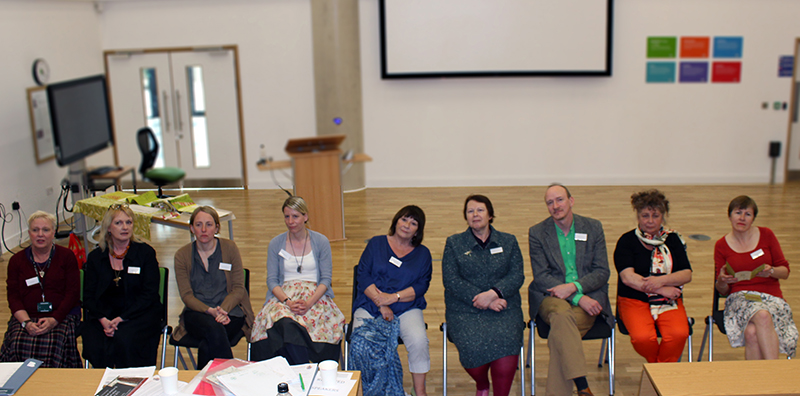
‘For thousands of years, the hand of man had directly fashioned the materials of his apparel, but now by a wonderful combination of automatic machines, which obey, like willing slaves, the will of the master mind, a power of production so infinite and various, so prodigious in its operations and results, as to surpass the fabled power of the ancient Genii, or the marvels of Arabian story, has been attained.’
John James, History of the Worsted Manufacture in England, 1857, pages 323-33
The prodigious production James observed as the Industrial Revolution was in progress has led to an infinite and various amount of material held within textile archive collections, stimulating, in turn, infinite and various responses by current academic researchers, historians and designers. This conference, held in the Michele Sutton Lecture Theatre at Bradford College on 22nd April 2015, presented an exciting and eclectic collection of these responses. The conference was opened by College Principal Kath 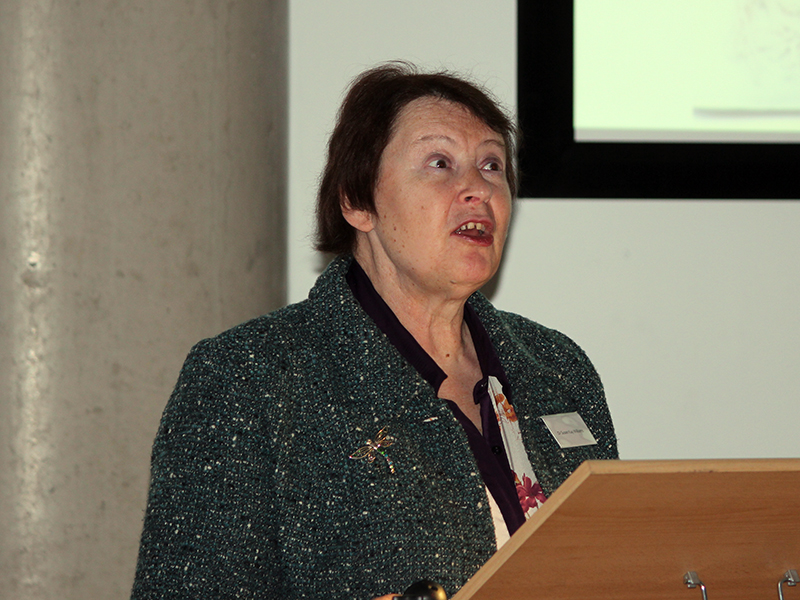 Oldale, who welcomed a large number of delegates which included artists, authors, curators, textile designers, teaching professionals and students to 'an interesting and informative day of sharing and engaging with research.'
Oldale, who welcomed a large number of delegates which included artists, authors, curators, textile designers, teaching professionals and students to 'an interesting and informative day of sharing and engaging with research.'
Dr Susan Kay-Williams, Chief Executive of the Royal School of Needlework gave a fascinating paper entitled Opening the Box – Rediscovering the Work of David Smith, Pre and Post 1856 Watershed Dyer. After explaining that ‘textile history is the hardest of the decorative arts to get to know', Dr Kay-Williams brought the work of this important nineteenth century dyer to life and revealed the constant joys of archival discovery.
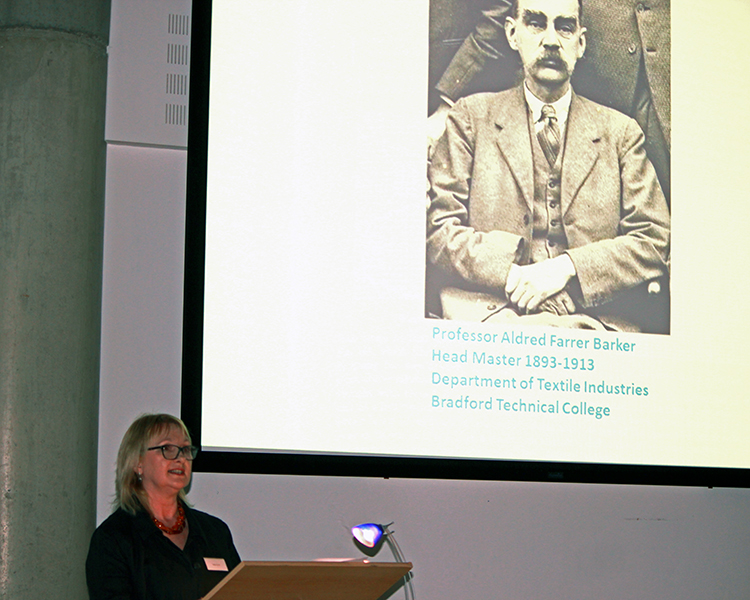 Helen Farrar, Curator of Textiles at Bradford College Textile Archive presented a comprehensively researched paper Pride, Precision, Productivity & Prosperity: Bradford’s Textile Education in 1900 which disclosed the visionary nature of textile education in 'Worstedopolis'. Pride in the College’s history and collections infused this absorbing presentation, where the ‘quality and depth of textile education’ made Bradford students 'ready for a life of innovation and prosperity.'
Helen Farrar, Curator of Textiles at Bradford College Textile Archive presented a comprehensively researched paper Pride, Precision, Productivity & Prosperity: Bradford’s Textile Education in 1900 which disclosed the visionary nature of textile education in 'Worstedopolis'. Pride in the College’s history and collections infused this absorbing presentation, where the ‘quality and depth of textile education’ made Bradford students 'ready for a life of innovation and prosperity.'
Pam Brook, Curriculum Team Leader for Creative Industries at Bradford School of Arts and Media, gave a fascinating paper, Material Worth: Innovations in Textile Manufacture in the Aire and Worth Valleys, focussing on the textile trade and developments in Keighley and surrounds from the seventeenth century onwards. She spoke of the difficulties and serendipity of textile archives as the survival of records depended on commercial firms, and she eloquently noted the 'shiver that a researcher gets when they make connections' with an unexpected contextual find.
Richard Ashworth, Colour Experience Manager, Society of Dyers & Colourists gave an illuminating scientific presentation, Colour, an Introduction, which explained the visual perception of colour and how the brain processes colour information. It was gratifying that he used carpet designs by our former lecturer and artist Sydney Harry as an example of colour theory, and he confounded expectations in a fun audience participation section.
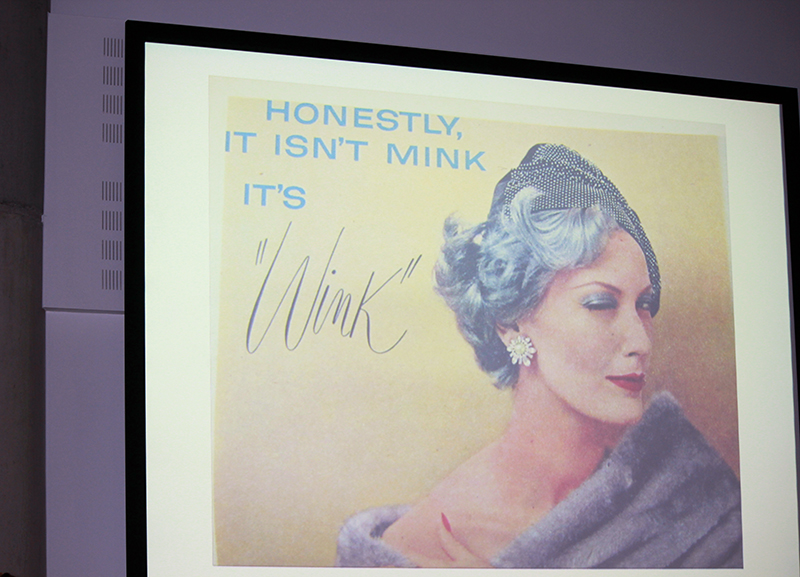 Liz McIvor, Curator of Social History and Technology for Bradford Museums, offered fascinating insights into comparatively recent, but forgotten, textile history with her presentation, Leopard for the legions: Making fashionable furs available to all - the rise of synthetics and the ethical debate. She explained that the race to salvage material from closing mills when Bradford Industrial Museum opened in the 1970s means that they held a wealth of archive material, including archived synthetic furs used in this research. Although these were not the usual types of samples and collections thought of as 'historic', they provided a context for change in industry and markets as well as a benchmark for what opinion regarding natural versus synthetic fibres. She described how furs were in demand as glamorous and aspirational luxuries during Bradford's textile heyday. Lister’s marketed new fur fabrics in 1970, blending natural and synthetic furs and exotic animal prints became very popular. As ethical and sustainability concerns came to the fore, the market declined but the original Lister's fur fabrics popular vintage items.
Liz McIvor, Curator of Social History and Technology for Bradford Museums, offered fascinating insights into comparatively recent, but forgotten, textile history with her presentation, Leopard for the legions: Making fashionable furs available to all - the rise of synthetics and the ethical debate. She explained that the race to salvage material from closing mills when Bradford Industrial Museum opened in the 1970s means that they held a wealth of archive material, including archived synthetic furs used in this research. Although these were not the usual types of samples and collections thought of as 'historic', they provided a context for change in industry and markets as well as a benchmark for what opinion regarding natural versus synthetic fibres. She described how furs were in demand as glamorous and aspirational luxuries during Bradford's textile heyday. Lister’s marketed new fur fabrics in 1970, blending natural and synthetic furs and exotic animal prints became very popular. As ethical and sustainability concerns came to the fore, the market declined but the original Lister's fur fabrics popular vintage items.
D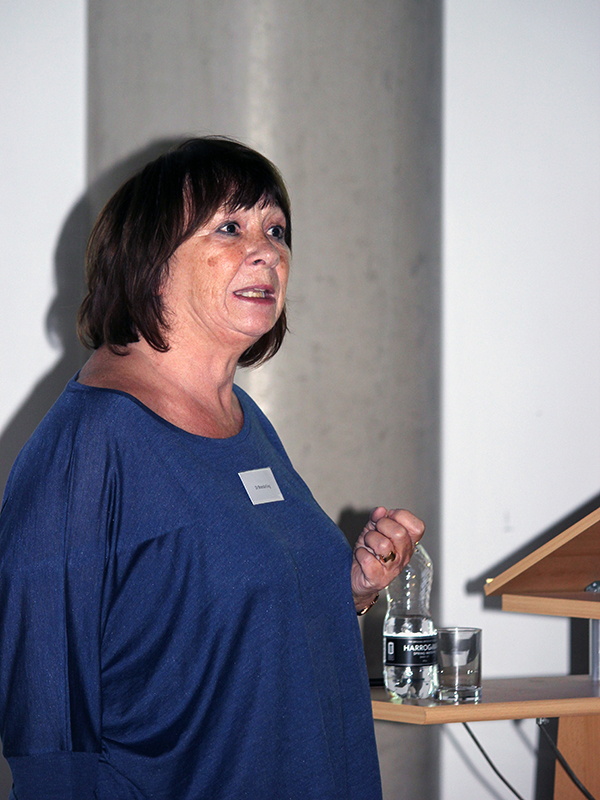 r Brenda King, author and Chair of The Textile Society, gave a masterly presentation, Full Circle:India-England-India, in which she spoke of her seminal research into collections of Indian silks in England and the lasting legacy of master dyer Thomas Wardle, President of the Bradford Society of Dyers and Colourists, and the samples he produced in the 1870s. She acknowledged a debt to Ruth Caswell for saving material which now comprises our magnificent Textile Archive. She recalled her first visit to College in 1995 to use the Forbes Watson Textile Fabrics of India when she found a clear link with student notebooks containing unexpected woven silk samples of a standard found in the silk centre of Macclesfield. Her discoveries took her to India to examine samples in Kolkata that were dyed with India’s dyestuffs in England, and back, to recount the fascinating story at home and abroad.
r Brenda King, author and Chair of The Textile Society, gave a masterly presentation, Full Circle:India-England-India, in which she spoke of her seminal research into collections of Indian silks in England and the lasting legacy of master dyer Thomas Wardle, President of the Bradford Society of Dyers and Colourists, and the samples he produced in the 1870s. She acknowledged a debt to Ruth Caswell for saving material which now comprises our magnificent Textile Archive. She recalled her first visit to College in 1995 to use the Forbes Watson Textile Fabrics of India when she found a clear link with student notebooks containing unexpected woven silk samples of a standard found in the silk centre of Macclesfield. Her discoveries took her to India to examine samples in Kolkata that were dyed with India’s dyestuffs in England, and back, to recount the fascinating story at home and abroad.
This was our very first Textile Archive conference, and given its success and the huge enthusiasm of speakers and delegates, it will undoubtedly be the first of many.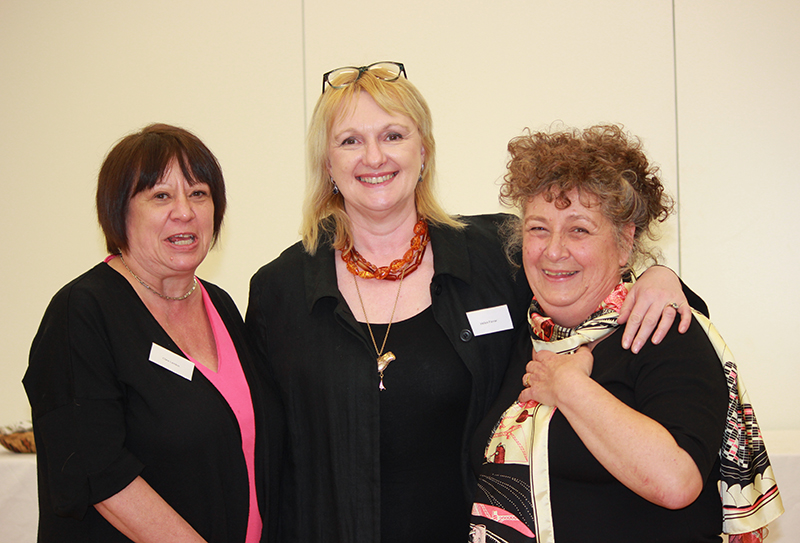
You can see images of the conference here